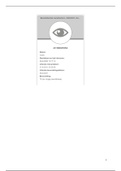Resume
Organisatie en Strategie: bijzondere vraagstukken - Samenvatting ()
- Établissement
- Universiteit Antwerpen (UA)
Samenvatting van het vak Organisatie en Strategie: bijzondere vraagstukken, gedoceerd door Paul Mathyssens in academiejaar . De samenvatting volgt de structuur van het handboek Radical Business Model Transformation en is aangevuld met de slides, lesnotities en academische papers van prof. Mathyssen...
[Montrer plus]













